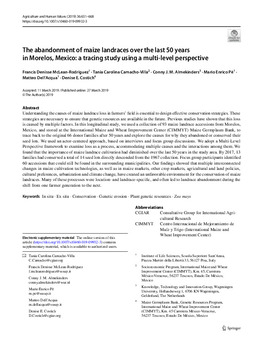The abandonment of maize landraces over the last 50 years in Morelos, Mexico: a tracing study using a multi-level perspective
Abstract
Understanding the causes of maize landrace loss in farmers’ field is essential to design effective conservation strategies. These strategies are necessary to ensure that genetic resources are available in the future. Previous studies have shown that this loss is caused by multiple factors. In this longitudinal study, we used a collection of 93 maize landrace accessions from Morelos, Mexico, and stored at the International Maize and Wheat Improvement Center (CIMMYT) Maize Germplasm Bank, to trace back to the original 66 donor families after 50 years and explore the causes for why they abandoned or conserved their seed lots. We used an actor-centered approach, based on interviews and focus group discussions. We adopt a Multi-Level Perspective framework to examine loss as a process, accommodating multiple causes and the interactions among them. We found that the importance of maize landrace cultivation had diminished over the last 50 years in the study area. By 2017, 13 families had conserved a total of 14 seed lots directly descended from the 1967 collection. Focus group participants identified 60 accessions that could still be found in the surrounding municipalities. Our findings showed that multiple interconnected changes in maize cultivation technologies, as well as in maize markets, other crop markets, agricultural and land policies, cultural preferences, urbanization and climate change, have created an unfavorable environment for the conservation of maize landraces. Many of these processes were location- and landrace-specific, and often led to landrace abandonment during the shift from one farmer generation to the next

